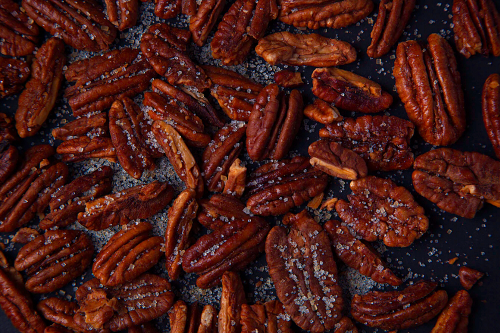Historian Wants to Clone Pecan Trees in Historic Bowie Grove Before Development. Developer Says Nut So Fast.
Rachael Pacella
One of Bowie’s first city commissioners didn’t just plant the seeds of government in the Washington suburb. He was a pecan fanatic.
Thomas P. Littlepage spent 15 years hunting across nine states for the best varieties of tree nuts in the early 20th century, then brought them back to his Bowie orchard, according to a pamphlet published in 1917 by his farm, Maryland Nut Nurseries.
Today, a portion of that land has been proposed for an 80-house development. Caruso Homes plans retain 61 out of 85 specimen trees on site, according to plans submitted to Prince George’ County officials.
Farmer Eliza Greenman, a member of the Northern Nut Growers Association who studies the history nuts and fruits, hopes to inspect the land before work begins, ideally in the fall when the walnuts, hazelnuts, pecans, oaks, hicans – a pecan hybrid – and sweet gum balls. Greenman testified about the horticultural importance of the land at a Bowie City Council meeting Monday evening.
She wants to analyze the remaining orchard and take cuttings from the trees so she can graft them to seedlings elsewhere, preserving the plants.
“Not having a plan to reproduce these trees could really be a death sentence for the horticultural history of this property,” she said.
Nancy Walsh, Caruso Homes Director of Executive Services, on Wednesday said there are no plans to allow cuttings.
The developer recognized the importance of the historic pecan grove and has submitted a conservation plan.
“My client, seeing the significance of the pecan trees has developed a plan and utilized a more arduous process,” said Ed Gibbs, an attorney representing Caruso Homes.
Preservation staff with the Maryland National Park and Planning Commission have recommended approval of the proposed development, noting its history as a part of Littlepage’s nursery and stating “the design and layout of the subject subdivision allows for the preservation of sensitive environmental features and supports the preservation of the pecan trees.”
“My client has been very responsible about recognizing the existence of the pecan grove and taking steps to preserve it,” Gibbs said.

The development is seeking the approval of the Prince George’s County Planning Board, which will consider the plan on Jan. 23. Monday, the Bowie City Council told Gibbs it would not support the application, citing concerns around traffic and the environment.
An excerpt from the October 1914 Harper’s Weekly article by J. Russell Smith goes into detail on the Littlepage’s passion, for which the attorney spent thousands in “time and travel expenses."
“He knew that every tree was a law unto itself. Where among many thousands of trees in the nine frosty states was the best parent tree for a northern pecan orchard?” Smith wrote. “He has spent fifteen years in answering that question.”
Some of the varieties available in the orchard, according to the Maryland Nut Nurseries catalog, were the small Niblack with a “delicate hickory flavor;” the Greenriver, an “aristocrat” of northern pecans; the Major, ideal with candy and confections; and Posey, a “rapid grower” that nearly always produces pecans with two whole halves of nut inside.
Other varieties included Warrick, Kentucky, Butterick, Indiana and Busseron. Using those selected varieties, Maryland Nut Nurseries produced young trees sold for about $1.50 each or $10 a dozen.
Littlepage didn’t grow his trees from seeds. He took a cutting from the original trees and grafted them onto seedlings. Greenman hopes to employ the same method to save the trees’ genetics today.
Nut trees aren’t “true to fruit,” Greenman said, which means the fruit new trees produce may look different than the parent plant. But by grafting a piece of an old tree onto a new one, horticulturists can assure everything from the graft up will grow identically to the original tree.
Greenman believes many of the trees cited in the catalog, curated for taste, size, growth rate and kernel, are still alive on the site.
“His farm was a repository for the most commercially viable nut of the era,” Greenman said.
Why nuts? Here is how W.C. Deming, former secretary of the Northern Nut Growers Association explained it in 1917:
“We must grow more of our food on trees. They may be a little slower in getting to work than grain crops that are sown in the spring and reaped in the fall if the weather and bugs permit, but once going trees last for many years and have a large independence of external conditions.”
Greenman also wants to study the area surrounding the grove to see how those trees have reproduced with trees outside the orchard. She runs a farm in Virginia growing heirloom and cider varieties of fruits.
According to the report from MNCPPC’s historic preservation staff Littlepage died in the 1940s and the land was sold to Julius and Birdie Lulley, and then again to William I. Patterson. He bred horses there for races in Bowie and Upper Marlboro.
Bowie never took off as a major nut farming city.








